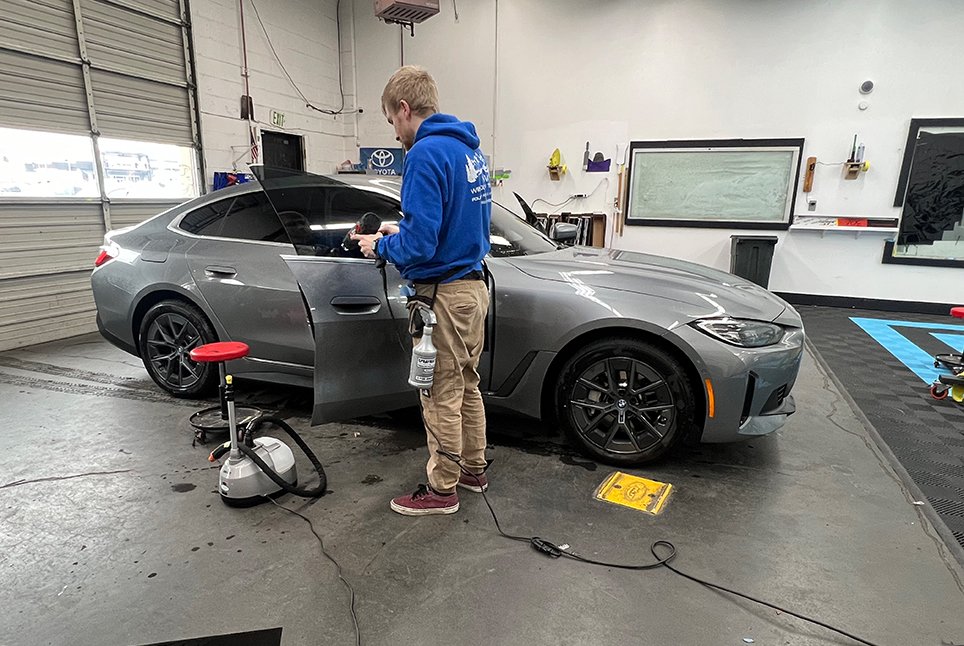Car Window Tinting: What to Anticipate Throughout the Installation Process
Car Window Tinting: What to Anticipate Throughout the Installation Process
Blog Article
Window Tinting Regulations and Standards: What You Need to Know Prior To Tinting Your Auto
Prior to continuing with window tinting for your vehicle, it is important to familiarize on your own with the diverse regulations and guidelines that control this technique across various states. These policies dictate the allowable degrees of color darkness, usually determined by visible light transmission (VLT) percentages, and consist of certain specifications for front windshields aimed at guaranteeing roadway safety.
Introduction of Window Tinting Rules
Window tinting regulations are often subject to variation across different jurisdictions, reflecting local laws and security considerations. These laws determine the allowable degrees of tint darkness and reflectiveness on automobile windows, making sure that motorists keep adequate presence while additionally protecting versus hazardous UV rays and warm.
A lot of regulations classify window tinting based on the Visible Light Transmission (VLT) percentage, which suggests the amount of light that can pass via the home window. Usually, lower VLT percents represent darker colors. Regulations often set apart in between the front, side, and back windows, with more stringent constraints used to the front windshield to boost safety and security for both the vehicle driver and other road customers.
Compliance with home window tinting regulations is important, as offenses can result in penalties, mandatory elimination of the tint, and potential increases in insurance premiums. It is important for vehicle owners to acquaint themselves with regional legislations before proceeding with home window tinting installations.
State-by-State Color Laws
Understanding the specific window tinting policies in each state is vital for vehicle owners seeking to conform with the regulation. Each state in the united state has developed its very own collection of policies regulating window tinting, which can differ considerably. These regulations commonly determine the permitted levels of color darkness, the kinds of windows that can be tinted, and any kind of medical exemptions that may apply.
For instance, states like The golden state have rigorous constraints on tint darkness for front windows, while others, such as New Mexico, may permit darker tints. Additionally, specific states mandate specific exposure portions for different home windows, including the windscreen, front side windows, and rear windows. It is critical for auto proprietors to acquaint themselves with their state's laws to avoid potential fines or fines.
Additionally, some states might require a certification sticker to be put on tinted home windows, indicating compliance with state regulations. Failing to follow these regulations not only runs the risk of lawful repercussions but can additionally affect safety and security and visibility while driving. Lorry owners must perform complete study or speak with neighborhood authorities to make sure complete understanding and conformity with state-by-state color policies.
Allowed Tint Degrees and Types
Several car proprietors might be amazed to find out that enabled color levels and types differ commonly throughout various states. Each state has established its own laws concerning the allowable darkness and reflectivity of window color, typically gauged by Visible Light Transmission (VLT) percents. VLT describes the amount of light that can travel through the tinted windows; thus, a lower percent indicates a darker color.

Furthermore, the kinds of color products permitted can differ, with some states prohibiting metal official statement or mirror-like coatings. It is important for car owners to familiarize themselves with their state's certain regulations to make certain compliance. Non-compliance can lead to penalties, compulsory removal of the tint, or other legal consequences, making it important to comprehend these laws before waging installation.
Medical Exceptions for Tinting
While not all states offer allowances for medical exceptions concerning home window tinting, those that do recognize the need for specific people to improve presence and my response convenience due to clinical problems. Numerous medical problems, such as lupus, skin cancer, and specific eye conditions, can make people especially sensitive to sunshine. Subsequently, these people might need darker colors to shield themselves from harmful UV rays and glow.

It is very important to keep in mind that despite a medical exception, there might still be restrictions on the degree of tint permitted. Compliance with state regulations makes sure that people are both protected and within lawful limitations. Those taking into consideration clinical exemptions need to contact their regional Division of Motor Vehicles or comparable authority to understand the demands and procedures essential to make an application for an exemption effectively.
Fines for Non-Compliance
Failing to abide with home window tinting laws can result in substantial fines, which differ by state. Legislation enforcement firms are encouraged to issue citations for cars that do not stick to the defined tinting policies. These fines usually include fines, which can vary from modest total up to several hundred bucks, relying on the severity of the infraction and the state concerned.
In some jurisdictions, duplicated offenses may cause intensifying penalties or extra penalties, such as mandatory court looks. Non-compliance might demand the elimination of illegal tinting, often at the proprietor's cost. In extreme situations, regular offenders might face suspension of their lorry registration till conformity is achieved.
In addition, insurance ramifications might occur from getting numerous citations for window tint offenses. Insurance providers may check out such offenses as an indication of riskier habits, possibly bring about boosted premiums or trouble in coverage.
To avoid these penalties, it is important for car owners to familiarize themselves with their regional home window tinting legislations and make sure that their car complies learn the facts here now (Window Tinting). This proactive strategy not only prevents legal ramifications however also advertises roadway security
Final Thought

A lot of regulations identify home window tinting based on the Visible Light Transmission (VLT) portion, which indicates the amount of light that can pass with the home window. Conformity with window tinting laws is crucial, as infractions can result in penalties, required removal of the color, and potential boosts in insurance costs.Understanding the specific window tinting guidelines in each state is crucial for lorry proprietors looking for to abide with the regulation. These guidelines typically dictate the permitted levels of color darkness, the types of home windows that can be tinted, and any kind of clinical exemptions that may use.
For instance, states like California have strict limitations on color darkness for front windows, while others, such as New Mexico, may allow darker tints.
Report this page